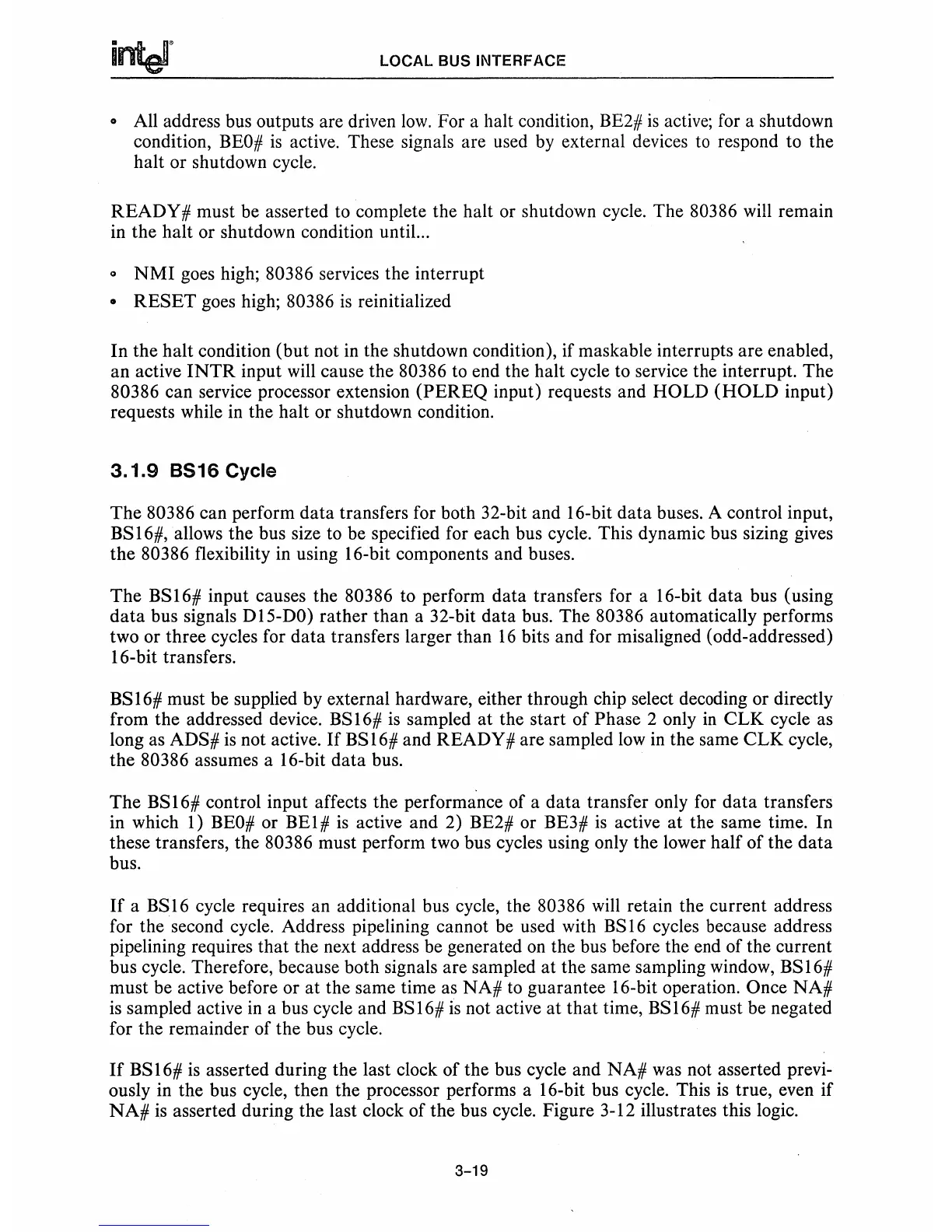LOCAL
BUS
INTERFACE
o All address bus outputs are driven
low.
For a halt condition, BE2#
is
active; for a shutdown
condition,
BEO#
is
active. These signals are used
by
external devices
to
respond to the
halt or shutdown cycle.
READY
# must be asserted to complete the halt or shutdown cycle. The 80386 will remain
in the halt or shutdown condition until...
Q
NMI
goes high; 80386 services the interrupt
•
RESET
goes high; 80386
is
reinitialized
In the halt condition (but not
in
the shutdown condition), if maskable interrupts are enabled,
an active
INTR
input will cause the 80386 to end the halt cycle to service the interrupt. The
80386 can service processor extension
(PEREQ
input) requests and
HOLD
(HOLD
input)
requests while in the halt or shutdown condition.
3.1.9
B516 Cycle
The
80386 can perform
data
transfers for both 32-bit and 16-bit
data
buses. A control input,
BS 16#, allows the bus size to be specified for each bus cycle. This dynamic bus sizing gives
the
80386 flexibility in using 16-bit components and buses.
The
BSI6#
input causes the 80386 to perform
data
transfers for a 16-bit data bus (using
data
bus signals DI5-DO) rather than a 32-bit data bus. The 80386 automatically performs
two or three cycles for
data
transfers larger than
16
bits and for misaligned (odd-addressed)
16-bit transfers.
BSI6#
must be supplied by external hardware, either through chip select decoding or directly
from the addressed device.
BSI6#
is
sampled
at
the start of Phase 2 only
in
CLK
cycle as
long
as
ADS#
is
not active.
If
BS 16# and
READY
# are sampled low
in
the same
CLK
cycle,
the
80386 assumes a 16-bit
data
bus.
The
BSI6#
control input affects the performance of a data transfer only for
data
transfers
in which 1)
BEO#
or
BEl#
is
active and 2) BE2# or BE3#
is
active
at
the same time. In
these transfers, the 80386 must perform two bus cycles using only the lower half of the
data
bus.
If
a BS16 cycle requires an additional bus cycle, the 80386 will retain the current address
for the second cycle. Address pipelining cannot be used with
BS
16
cycles because address
pipelining requires that the next address be generated
on
the bus before the end of the current
bus cycle. Therefore, because both signals are sampled
at
the same sampling window, BS16#
must be active before or
at
the same time as
NA#
to guarantee 16-bit operation. Once
NA#
is
sampled active
in
a bus cycle and
BS
16#
is
not active
at
that
time,
BS
16# must be negated
for the remainder of the bus cycle.
If
BS16#
is
asserted during the last clock of the bus cycle and
NA#
was not asserted previ-
ously in the bus cycle, then the processor performs a 16-bit bus cycle. This
is
true, even
if
NA#
is
asserted during the last clock of the bus cycle. Figure 3-12 illustrates this logic.
3-19

